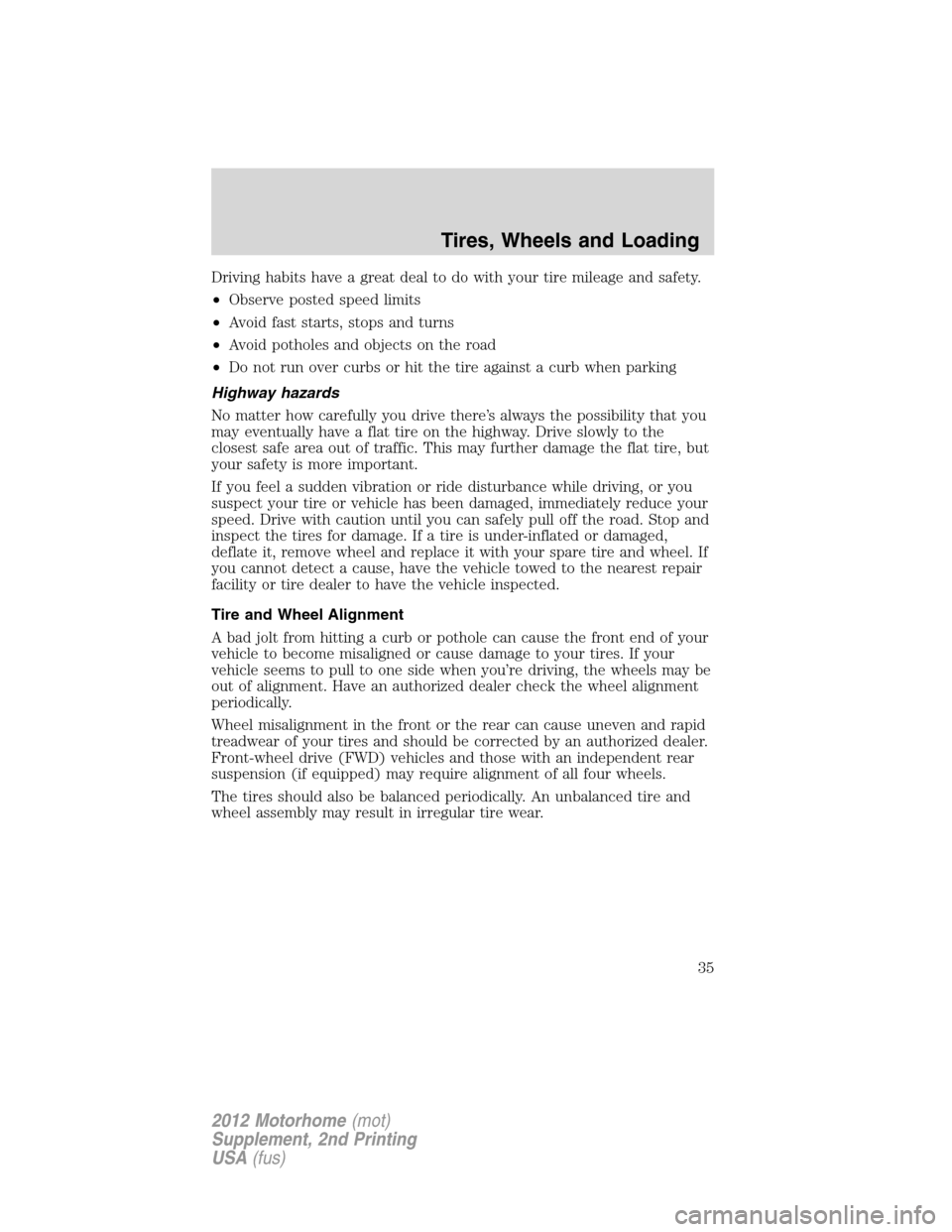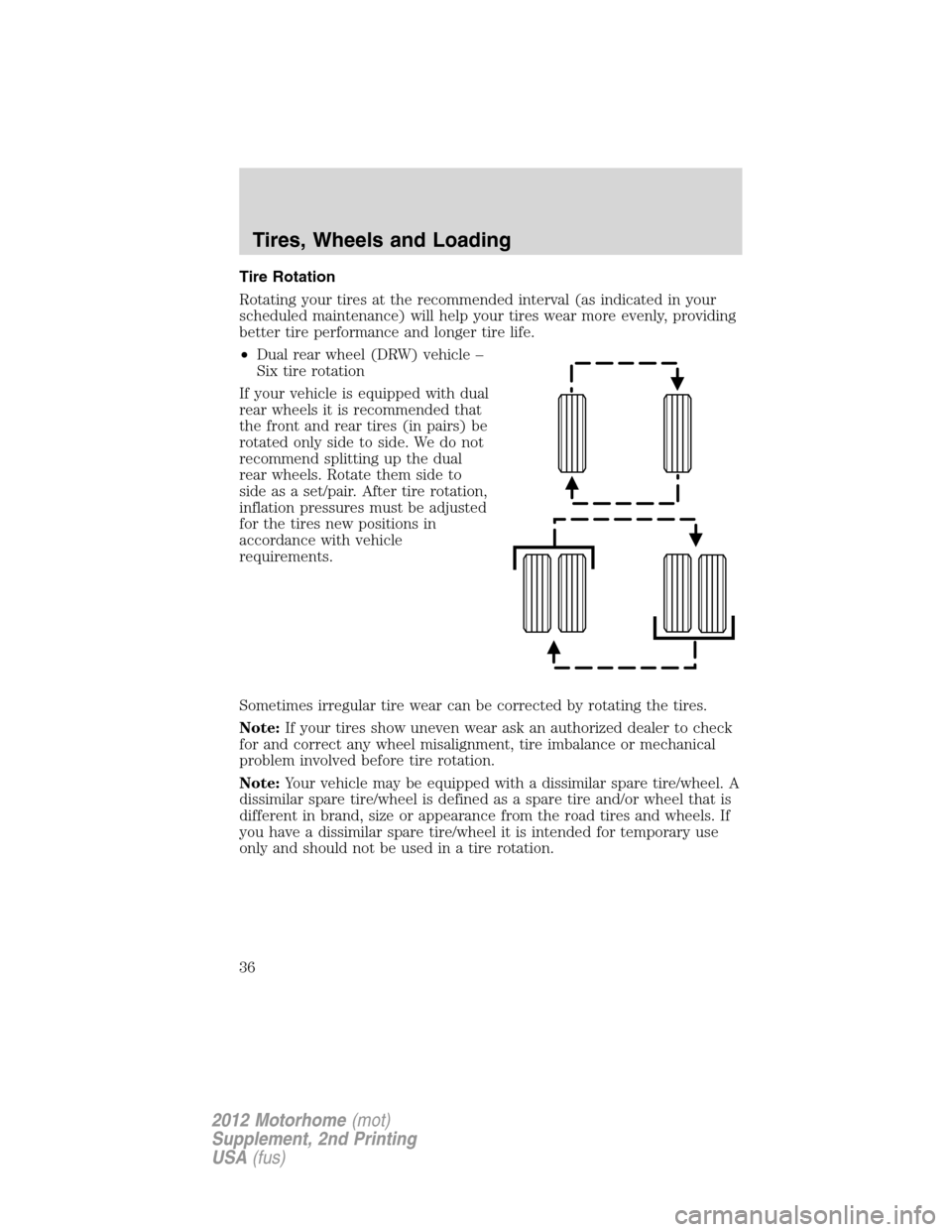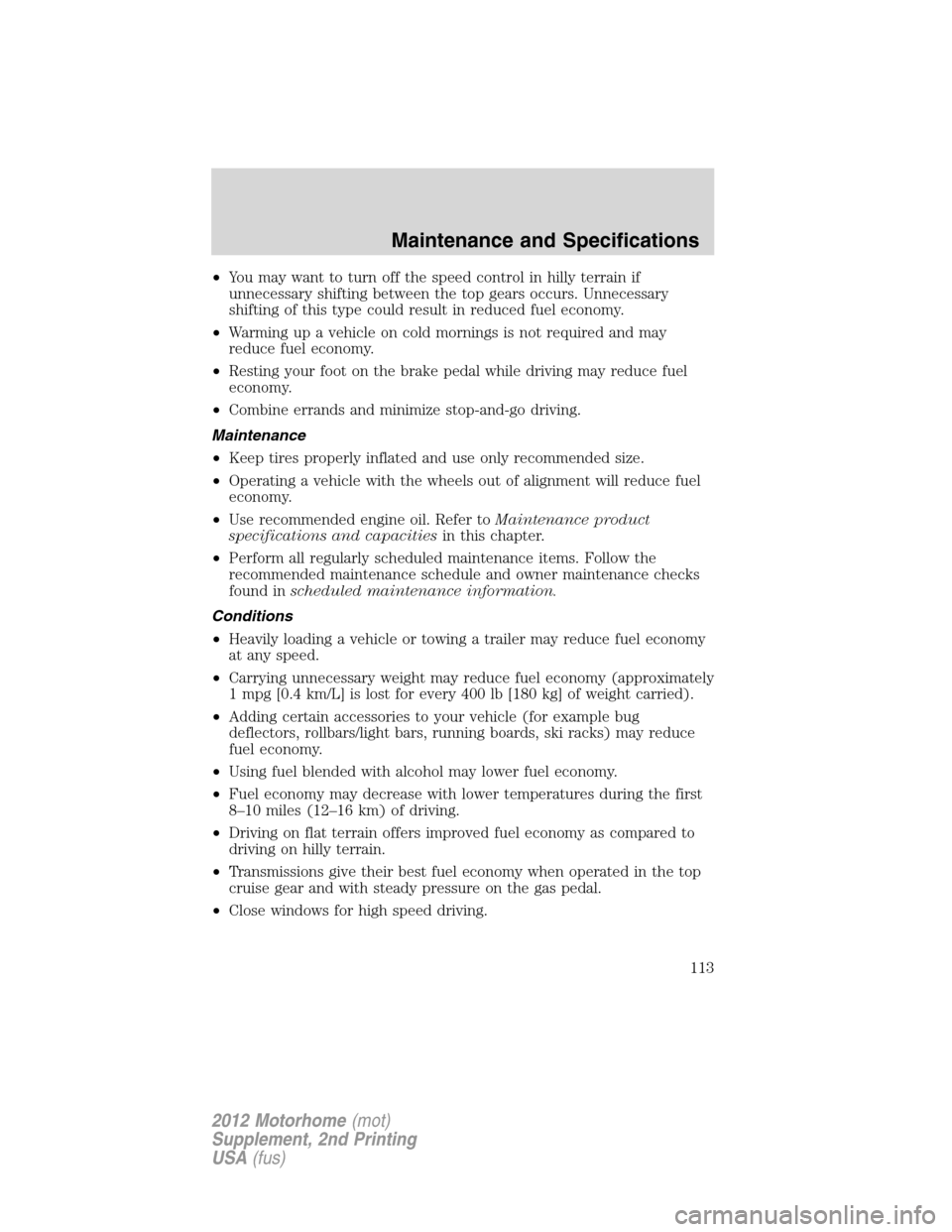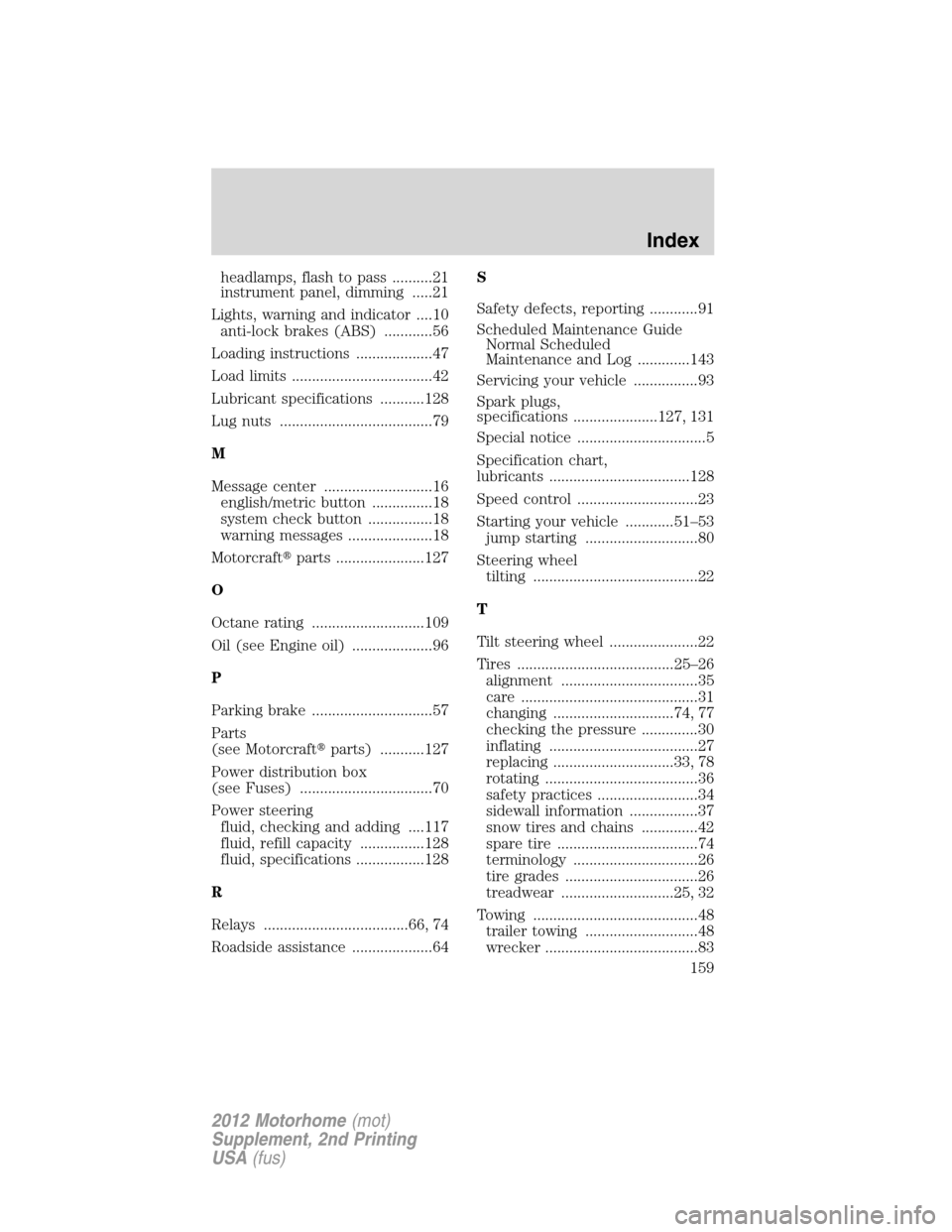Page 35 of 160

Driving habits have a great deal to do with your tire mileage and safety.
•Observe posted speed limits
•Avoid fast starts, stops and turns
•Avoid potholes and objects on the road
•Do not run over curbs or hit the tire against a curb when parking
Highway hazards
No matter how carefully you drive there’s always the possibility that you
may eventually have a flat tire on the highway. Drive slowly to the
closest safe area out of traffic. This may further damage the flat tire, but
your safety is more important.
If you feel a sudden vibration or ride disturbance while driving, or you
suspect your tire or vehicle has been damaged, immediately reduce your
speed. Drive with caution until you can safely pull off the road. Stop and
inspect the tires for damage. If a tire is under-inflated or damaged,
deflate it, remove wheel and replace it with your spare tire and wheel. If
you cannot detect a cause, have the vehicle towed to the nearest repair
facility or tire dealer to have the vehicle inspected.
Tire and Wheel Alignment
A bad jolt from hitting a curb or pothole can cause the front end of your
vehicle to become misaligned or cause damage to your tires. If your
vehicle seems to pull to one side when you’re driving, the wheels may be
out of alignment. Have an authorized dealer check the wheel alignment
periodically.
Wheel misalignment in the front or the rear can cause uneven and rapid
treadwear of your tires and should be corrected by an authorized dealer.
Front-wheel drive (FWD) vehicles and those with an independent rear
suspension (if equipped) may require alignment of all four wheels.
The tires should also be balanced periodically. An unbalanced tire and
wheel assembly may result in irregular tire wear.
Tires, Wheels and Loading
35
2012 Motorhome(mot)
Supplement, 2nd Printing
USA(fus)
Page 36 of 160

Tire Rotation
Rotating your tires at the recommended interval (as indicated in your
scheduled maintenance) will help your tires wear more evenly, providing
better tire performance and longer tire life.
•Dual rear wheel (DRW) vehicle –
Six tire rotation
If your vehicle is equipped with dual
rear wheels it is recommended that
the front and rear tires (in pairs) be
rotated only side to side. We do not
recommend splitting up the dual
rear wheels. Rotate them side to
side as a set/pair. After tire rotation,
inflation pressures must be adjusted
for the tires new positions in
accordance with vehicle
requirements.
Sometimes irregular tire wear can be corrected by rotating the tires.
Note:If your tires show uneven wear ask an authorized dealer to check
for and correct any wheel misalignment, tire imbalance or mechanical
problem involved before tire rotation.
Note:Your vehicle may be equipped with a dissimilar spare tire/wheel. A
dissimilar spare tire/wheel is defined as a spare tire and/or wheel that is
different in brand, size or appearance from the road tires and wheels. If
you have a dissimilar spare tire/wheel it is intended for temporary use
only and should not be used in a tire rotation.
Tires, Wheels and Loading
36
2012 Motorhome(mot)
Supplement, 2nd Printing
USA(fus)
Page 113 of 160

•You may want to turn off the speed control in hilly terrain if
unnecessary shifting between the top gears occurs. Unnecessary
shifting of this type could result in reduced fuel economy.
•Warming up a vehicle on cold mornings is not required and may
reduce fuel economy.
•Resting your foot on the brake pedal while driving may reduce fuel
economy.
•Combine errands and minimize stop-and-go driving.
Maintenance
•Keep tires properly inflated and use only recommended size.
•Operating a vehicle with the wheels out of alignment will reduce fuel
economy.
•Use recommended engine oil. Refer toMaintenance product
specifications and capacitiesin this chapter.
•Perform all regularly scheduled maintenance items. Follow the
recommended maintenance schedule and owner maintenance checks
found inscheduled maintenance information.
Conditions
•Heavily loading a vehicle or towing a trailer may reduce fuel economy
at any speed.
•Carrying unnecessary weight may reduce fuel economy (approximately
1 mpg [0.4 km/L] is lost for every 400 lb [180 kg] of weight carried).
•Adding certain accessories to your vehicle (for example bug
deflectors, rollbars/light bars, running boards, ski racks) may reduce
fuel economy.
•Using fuel blended with alcohol may lower fuel economy.
•Fuel economy may decrease with lower temperatures during the first
8–10 miles (12–16 km) of driving.
•Driving on flat terrain offers improved fuel economy as compared to
driving on hilly terrain.
•Transmissions give their best fuel economy when operated in the top
cruise gear and with steady pressure on the gas pedal.
•Close windows for high speed driving.
Maintenance and Specifications
113
2012 Motorhome(mot)
Supplement, 2nd Printing
USA(fus)
Page 159 of 160

headlamps, flash to pass ..........21
instrument panel, dimming .....21
Lights, warning and indicator ....10
anti-lock brakes (ABS) ............56
Loading instructions ...................47
Load limits ...................................42
Lubricant specifications ...........128
Lug nuts ......................................79
M
Message center ...........................16
english/metric button ...............18
system check button ................18
warning messages .....................18
Motorcraft�parts ......................127
O
Octane rating ............................109
Oil (see Engine oil) ....................96
P
Parking brake ..............................57
Parts
(see Motorcraft�parts) ...........127
Power distribution box
(see Fuses) .................................70
Power steering
fluid, checking and adding ....117
fluid, refill capacity ................128
fluid, specifications .................128
R
Relays ....................................66, 74
Roadside assistance ....................64S
Safety defects, reporting ............91
Scheduled Maintenance Guide
Normal Scheduled
Maintenance and Log .............143
Servicing your vehicle ................93
Spark plugs,
specifications .....................127, 131
Special notice ................................5
Specification chart,
lubricants ...................................128
Speed control ..............................23
Starting your vehicle ............51–53
jump starting ............................80
Steering wheel
tilting .........................................22
T
Tilt steering wheel ......................22
Tires .......................................25–26
alignment ..................................35
care ............................................31
changing ..............................74, 77
checking the pressure ..............30
inflating .....................................27
replacing ..............................33, 78
rotating ......................................36
safety practices .........................34
sidewall information .................37
snow tires and chains ..............42
spare tire ...................................74
terminology ...............................26
tire grades .................................26
treadwear ............................25, 32
Towing .........................................48
trailer towing ............................48
wrecker ......................................83
Index
159
2012 Motorhome(mot)
Supplement, 2nd Printing
USA(fus)